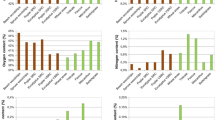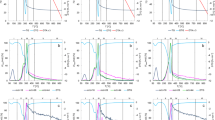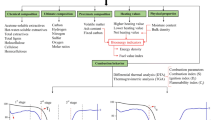Abstract
Biomass such as wood, straw or agricultural wastes are a worldwide abundant resource offering high potential for a decentralized energy production and supply which is especially interesting for rural areas. However, substance and energy loss caused by microbial degradation is one major reason for high feedstock costs. As a consequence of the microbial activity and further exothermic processes, heat is produced inside stored piles, leading to temperatures >200 °C, causing partial pyrolysis and self-ignition. This work investigates the degradation process of spruce forest residues in order to generate a better knowledge about underlying processes and possible counteractions. Therefore, the microbial metabolic activity has been described in dependency on the moisture content (MC), particle size distribution and pH by respirometric tests. Respirometric tests revealed the microbial activity over time showing a maximum within the first few days of storage. Our results show that the moisture content is a key factor during wood degradation. No microbial activity could be verified for a MC < 20%. A moisture content of 46% led to a monthly dry matter loss of 5.4%. Raising the pH to an alkaline environment reduced the monthly dry matter loss from 3.1 to 1.8% per month proofing it´s influence on microbial metabolic activity. Further investigations have to be conducted to clarify underlying mechanism and countermeasures.
You have full access to this open access chapter, Download conference paper PDF
Similar content being viewed by others
Keywords
10.1 Introduction
For the generation of thermal energy, wood is the most commonly used biogenic resource, offering various advantages including CO2-neutral energy production. Especially in Europe, wood is an abundant resource applicable independently of season and weather. In district heating plants especially, forest biomass in the form of high-quality woodchips, as well as woody waste such as bark, sawdust or forest residues, is a common combustible material. After harvest, the biomass is usually stored over a period of time before utilization. During the storage, destruction and conversion processes take place inevitably. Different bacteria and mold fungi colonize the biomass, causing its degradation. These microbes originate from the natural microbial community present in the biogenic material as well as from atmospheric deposition [1]. Basidiomycetes are the main wood rotters due to their ability to degrade cellulose, hemicellulose and lignin. These fungi can overcome difficulties in wood decay such as limited nutrient accessibility and the presence of antibiotic compounds (essential oils) [2]. Moreover, they can grow over a wide temperature and pH range. The degradation of the wood components is carried out in aerobic conditions [3]. These degradation or respiration processes result in an economical relevant dry-matter loss and consequently in a net-energy-value reduction.
Data regarding the weight loss of woodchips differ widely, indicating fluctuations due to different test setups used, unseasonal conditions and biomass properties. Also, the method being used for quantifying the dry-matter loss exerts great influence. Several European research groups are focusing on determining the behaviour of woodchips during storage and postulated an annual biomass loss of 10–40% [4,5,6,7,8,9,10,11,12,13,14,15,16]. Buggeln suggested a rule of thumb of 1% dry-matter loss per month in outside storage, which is accurate for woodchips of high quality [9]. However, this value is underestimating the dry-matter loss of woodchips containing bark or forest residues.
Primary factors influencing the degradation rate are the temperature, water content and oxygen availability [11]. Also, pH and nutrient availability are the main microbial growth factors either promoting or inhibiting microbial growth. These factors are mainly influenced by the pile geometry, piling method, particle size, comminution method, storage season, storage location and the tree species [3, 6, 10, 12, 13].
As an example, woodchips containing sawdust and fine materials such as needles offer a greater surface to be attacked by microbes and cause limited air passage, leading to higher pile temperatures [6]. Pecenka et al. [10] showed a monthly dry-matter loss of 1.0–3.6% for poplar woodchips of varying particle sizes, showing higher dry-matter loss for smaller particles. The compaction of the pile leads to heat accumulation and affects the fungal growth negatively. The pile geometry influences rainwater entry as well as pile compaction and heat dissipation depending on the volume-to-surface-area ratio [13, 14]. All mentioned studies proved a significant correlation between pile temperature and dry-matter loss.
However, detailed knowledge about what factors influence the degradation process to what extent are still missing, and further investigations have to be carried out for a better understanding of the underlying processes.
A woodchip pile by itself is an inhomogeneous system consisting of different layers, offering varying growth conditions for microorganisms leading to difficulties in the dry matter loss determination [16].
Against this background, a method has been implemented in the laboratory to simulate different storage conditions and pile layers in order to describe the degradation process according to its dependency on ambient conditions. Generally, the biodegradability of organic compounds is tested by respirometric tests, where the carbon dioxide (CO2) produced during the degradation process is quantified. This method offers an accurate determination of the degradation rate under certain ambient conditions and can visualize the microbial activity. In this study, respirometric tests have been conducted for forest residues from spruce, aiming to describe the degradation process. The influence of the moisture content, particle size distribution and pH on the dry-matter loss has been investigated.
10.2 Materials and Methods
10.2.1 Respirometric Tests
The biodegradability of spruce woodchips and forest residues was tested via a modification of ISO-14852, where the CO2 produced during the degradation process was quantified [17]. Figure 10.1 shows the experimental setup. The reactors were filled with 500–1000 g fresh woodchips and were incubated at varying moisture contents, particle sizes and pH values.
All reactors were covered with glass wool and aluminium foil as insulation and to keep dark test conditions. In order to keep aerobic conditions, air was continuously pumped into the reactor at a flow rate of about 0.01 m3/h. Before entering the reactor, the air was passed through an absorption bottle with soda lime to remove atmospheric CO2 and a bottle with either water for tests with moist material or silica gel for tests with dry test material. CO2 that was produced during the test was flushed through three absorption bottles with 0.5 M sodium hydroxide, forming sodium bicarbonate. The concentration of CO2 was determined by means of a two-step titration with hydrochloride acid, phenolphthalein and methyl orange as indicators. For calculating the wood degradation (%) it has been assumed that mainly hemicellulose is attacked and degraded within this period of time. Thermal gravimetric tests confirmed this assumption (data not shown).
10.2.2 Samples and Test Conditions
Prior to the test, fresh spruce woodchips were sieved according to ÖNORM EN 15149-1, and the reactors were filled with a defined quantity of each fraction [18]. The moisture content of the material was determined by drying three samples at 105 °C to constant weight at the beginning and at the end of each experiment.
In order to better understand the influence of the particle size distribution and the fine-material content on the degradation process, experiments were conducted with coarse, medium and fine woodchips according to Fig. 10.2. The coarse material contained a fine-material content (<3.15 mm) of 0%, medium 10% and fine woodchips 20%. A medium particle size distribution was selected for all other experiments.
The influence of the pH was investigated by adding 5 and 10% (w/w) of calcium carbonate to fresh forest residues and incubating for 45 days.
10.3 Results and Discussion
10.3.1 Influence of the Moisture Content
Respirometric tests have been conducted with forest residues with a moisture content of 46, 30, 20 and 17%, respectively. The moisture content was lowered from 46% by means of a convection dryer at 20 °C. Figure 10.3 illustrates the CO2 production rate over time and the dry matter losses at varying water contents.
Taking a look at the different curves, an increase of microbial activity with increasing moisture content is seen. Forest residues with a MC of 20% showed very low activity. Below this value, no activity could be proven, marking the minimum water availability needed for microbial growth. After 10 days the activity started to decrease for all test conditions. However, as our results showed, at 35% MC the CO2 production decreased steadily, whereas at higher moisture contents, there was still a high CO2 production rate, which remained static at 0.1 g (h−1 kg−1).
The present study shows the moisture content is a key factor of the wood degradation process. The decomposition of sugars and other wood components occur predominantly in the thin liquid films on the wood’s surface. Optimal microbe growth takes place at a moisture content between 30 and 60%. A minimum of 20% is crucial for the growth of different fungi [2]. As we could show, drying the biomass has a great effect on the storage stability (low dry matter loss, low risk of self-ignition) but humidification has to be prevented by either a semi-permeable fleece or by storing the biomass in a hall.
10.3.2 Variation of Particle Sizes
In order to investigate the influence of particle size distribution on the microbial activity, varying particle sizes were prepared. Figure 10.4 shows the correlation between the microbial activity and the fine-material content over a period of 30 days. The activity of fine and medium woodchips was very similar. On the contrary, the coarse material showed the highest activity and dry matter loss with 4.9%. In this test run, the CO2 production rate showed strong fluctuations, which probably is due to changes in temperature (22 ± 5 °C). Further experiments have to be conducted including single particle size fractions.
10.3.3 Variation of the pH
Figure 10.5 shows the CO2 production rate and dry matter losses over time. Adding 5% (w/w) CaCO3 increased the pH value to 8.5 and 10% (w/w) CaCO3 increased pH to 9.0.
A clear difference in the microbial activity was seen within the first two weeks of incubation. Adding CaCO3 to the woodchips led to a suppression of fungal growth and activity. The dry-matter loss (in w/w) in the first month amounted to 3.1 for 0% CaCO3, 2.5 for 5% CaCO3 and 1.8 for 10% CaCO3. However, no repetition of the experiments have been done so far. Further long-term tests and different additives as well as concentrations have to be investigated. However, a rise in pH did inhibit most of the mold fungi, leading to minimal wood degradation. Thus, adding alkaline substances to the woodchips during storage might suppress the initial temperature increase and lower self-ignition risk. Our previous investigation showed a direct link of microbial activity and a temperature rise within the first week of storage. This assumption has to be investigated in a further project. Additives such as chalk and dolomite not only have the potential to inhibit fungal wood decay but also are used as agents for the combustion of agrarian residues, such as straw, leading to a higher ash melting point.
10.4 Conclusion and Outlook
Respirometric tests on spruce forest residues were conducted under different moisture contents (15–50%), particle sizes (fine, medium, coarse) and pH values (addition of 5 and 10% of CaCO3). The moisture content played a major role during the degradation process. Drying the woodchips to less than 30% reduced the microbial activity and dry-matter loss significantly. At below 20%, no activity could be verified. Increasing the pH to a minimum value of 9 inhibited fungal growth significantly, offering a good alternative for conserving biomass. The influence of the particle size distribution was less distinct as expected but further experiments are crucial for gaining more insight into this.
It can be concluded that respirometric tests provide an accurate way to determine the wood degradation rate, showing a high potential to investigate the wood degradation process. Further improvements have to be completed especially if different test temperatures will be investigated. It is possible to determine the microbial activity over time, with the highest activity occurring within the first few days of storage. This initial activity is responsible for the very high temperatures inside the woodchip piles, which could reach up to 80 °C. Further experiments will be conducted with different test materials and under varying test conditions. In parallel, soil-block decay tests will be conducted and the wood degradation will be investigated by chemical and thermal gravimetric analyses. Additionally, the degraded biomass will be tested in a small scale gasification plant do investigate the influence on the gasification and combustion process and the obtained product gas.
References
M. Noll, R. Jirjis, Microbial communities in large-scale wood piles and their effects on wood quality and the environment. Appl. Microbiol. Biotechnol. 95(3), 551–563 (2012)
A.T. Martínez, M. Speranza, F.J. Ruiz-Dueñas, P. Ferreira, S. Camarero, F. Guillén, Biodegradation of lignocellulosics: microbial, chemical and enzymatic aspects of the fungal attack of lignin. Int. Microbiol. 8, 195–204 (2005)
Wd Boer, L.B. Folman, R.C. Summerbell, L. Boddy, Living in a fungal world: impact of fungi on soil bacterial niche development. FEMS Microbiol. Rev. 29(4), 795–811 (2005)
V. Scholz, C. Idler, W. Daries, J. Egert, Lagerung von Feldholzhackgut. Agrartechnische Forschung 4, 100–113 (2005)
T. Thörnqvist, Drying and storage of forest residues for energy production. Biomass 7(2), 125–134 (1985)
M. Barontini, A. Scarfone, R. Spinelli, F. Gallucci, E. Santangelo, A. Acampora et al., Storage dynamics and fuel quality of poplar chips. Biomass Bioenergy 62, 17–25 (2014)
C. Whittaker, W. Macalpine, N.E. Yates, I. Shield, Dry matter losses and methane emissions during wood chip storage: the impact on full life cycle greenhouse gas savings of short rotation coppice willow for heat. Bioenergy Res. (2016)
X. He, A.K. Lau, S. Sokhansanj, C. Jim Lim, X.T. Bi, S. Melin, Dry matter losses in combination with gaseous emissions during the storage of forest residues. Fuel 95, 662–664 (2012)
R. Buggeln, Outside storage of wood chips. Biocycle 40, 32–34 (1999)
R. Pecenka, H. Lenz, C. Idler, W. Daries, D. Ehlert, Development of bio-physical properties during storage of poplar chips from 15 ha test fields. Biomass Bioenergy 65, 13–19 (2014)
S.M. Kazemi, D.J. Dickinson, R.J. Murphy, Effects of initial moisture content on wood decay at different levels of gaseous oxygen concentrations. J. Agric. Sci. Technol. 3, 293–304 (2001)
F. Ferrero, M. Malow, M. Noll, Temperature and gas evolution during large scale outside storage of wood chips. Eur. J. Wood Prod. 69(4), 587–595 (2011)
M.A. Brand, M. Bolzon de, I. Graciela, W.F. Quirino, J.O. Brito, Storage as a tool to improve wood fuel quality. Biomass Bioenergy 35(7), 2581–2588 (2011)
T. Filbakk, G. Skjevrak, O. Høibø, J. Dibdiakova, R. Jirjis, The influence of storage and drying methods for Scots pine raw material on mechanical pellet properties and production parameters. Fuel Process. Technol. 92(5), 871–878 (2011)
R. Pecenka, H. Lenz, C. Idler, W. Daries, D. Ehlert, Efficient Harvest and Storage of Field Wood for Profitable Production of Bioenergy from Short Rotation Coppice, in 21st European Biomass Conference and Exhibition, Kopenhagen, Denmark 2013, pp. 120–124
R. Jirjis, Storage and drying of wood fuel. Biomass Bioenergy 9(1–5), 181–190 (1995)
Determination of the ultimate aerobic biodegradability of plastic materials in an aqueous medium—Method by analysis of evolved carbon dioxide (ISO 14852:1999): Bureau of Indian Standards, 1999
Austrian Standards. ÖNORM EN 15149-1 - Feste Biobrennstoffe - Bestimmung der Partikelgrößenverteilung - Teil 1: Rüttelsiebverfahren mit Sieb-Lochgrößen von 1 mm und darüber (ÖNORM EN 15149-1), 2010
Acknowledgements
This work was supported by the government of Tyrol and the Tiroler Standortagentur of the research program, Tiroler Kooperationsförderung. Thanks are due to the partners of this project, namely MCI-The Entrepreneurial School®, SYNECO-tec GmbH, Syneco Consulting, Südtiroler Energieverband and Bioenergie Tirol Nahwärme GmbH, with all district heating plants being part of the research.
Author information
Authors and Affiliations
Corresponding author
Editor information
Editors and Affiliations
Rights and permissions
<SimplePara><Emphasis Type="Bold">Open Access</Emphasis> This chapter is licensed under the terms of the Creative Commons Attribution 4.0 International License (http://creativecommons.org/licenses/by/4.0/), which permits use, sharing, adaptation, distribution and reproduction in any medium or format, as long as you give appropriate credit to the original author(s) and the source, provide a link to the Creative Commons license and indicate if changes were made.</SimplePara> <SimplePara>The images or other third party material in this book are included in the book's Creative Commons license, unless indicated otherwise in a credit line to the material. If material is not included in the book's Creative Commons license and your intended use is not permitted by statutory regulation or exceeds the permitted use, you will need to obtain permission directly from the copyright holder.</SimplePara>
Copyright information
© 2018 The Author(s)
About this paper
Cite this paper
Dumfort, S., Kirchmair, C., Floerl, K., Larch, C., Rupprich, M. (2018). Storage as the Weak Link of the Biomass Supply Chain. In: Mpholo, M., Steuerwald, D., Kukeera, T. (eds) Africa-EU Renewable Energy Research and Innovation Symposium 2018 (RERIS 2018). RERIS 2018. Springer Proceedings in Energy. Springer, Cham. https://doi.org/10.1007/978-3-319-93438-9_10
Download citation
DOI: https://doi.org/10.1007/978-3-319-93438-9_10
Published:
Publisher Name: Springer, Cham
Print ISBN: 978-3-319-93437-2
Online ISBN: 978-3-319-93438-9
eBook Packages: EnergyEnergy (R0)









